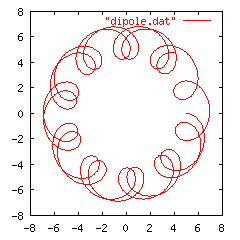Computational Physics Tutorial
ICTP Autumn College
on Plasma Physics, October 2001
Bill Dorland (Imperial College and Univ. of Maryland)
and Greg Hammett (Imperial College and Princeton Plasma
Physics Lab)
Main Reference: Computational
Physics Notes by Prof. Angus MacKinnon, Imperial College.
Other useful references:
ICTP
Computer Guide, good collection describing ICTP's excellent computer
facilities and software.
Numerical Recipes: The Art of Scientific
Computing. Free online copy of every chapter, enjoyable reading
on the history and logic of various algorithms.
Netlib repository of free high-quality
numerical software.
Chebyshev
and Fourier Spectral Methods, by John P. Boyd. Excellent description
of the best state of the art algorithms.
Attendees at the ICTP have a wide range of backgrounds and computer
experience. Some have primarily done analytic theoretical physics
or are rusty on computer skills, while some have written advanced nonlinear
plasma simulation codes. We will try to cover a wide range of topics,
starting with some of the fundamentals and including some advanced topics.
Lecture I. Introduction to numerical methods for ODE's:
Accuracy and stability properties of 1st order Euler, Centered Implicit,
Leap Frog, 2cd Order Runge-Kutta.
Project
I: Write a short program to test various algorithms to integrate
the equations of motion for a particle gyrating in a constant magnetic
field, with and without a drag term. Try various algorithms, investigating
which one conserves energy the best while remaining stable in the presence
of drag. Other extensions of this project in MacKinnon.
Sample programs to start with for this and other projects are accessible
on ICTP computers in directory "/afs/ictp/public/h/hammettg".

Lecture II. More on ODE's: Adams-Bashforth
algorithm. Why implicit methods might be difficult to implement (requires
inversion of a matrix). Partially implicit iterative methods.
Why one may want to do centered implicit for wave type problems and off-centered
implicit for damping type problems.
Project II: Extend code of Project I to plot orbits of
a particle precessing around a dipole magnetic field (such as particles
trapped in the earth's magnetic field). (For simplicity, use the
v_z=0 limit where the particle stays in the (x,y) plane.) You should
be able to show that a second-order method is a hundred times faster than
simple first-order Euler for this problem.
Lecture/Demo III: Demo of Birdsall
and Langdon's ES1 Particle code on 2-stream instabilities.
Additional Lectures and Demos in Week III...: Nonlinear PDE's,
Spectral methods and dealiasing, Modern programming techniques in Fortran-90,
Parallel Programming.
